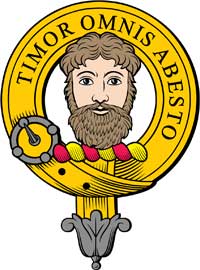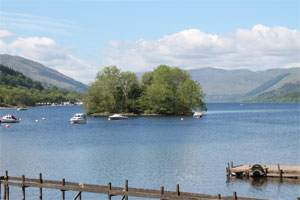This is the third episode on our series that explores the meaning behind some of the best known clan crests. Today Rodger Moffet gets his ‘head around’ Clan MacNab.

Clan MacNab are a Highland clan from the area around Killin at the head of Loch Tay. The name MacNab comes from Mac an Abu, meaning “the son of the abbot”. The crest for MacNab is the head of a savage. You would be forgiven for thinking that this noble looking head was that of the progenitor of the clan or even a famous MacNab chief – its a clan chief alright bit not a MacNab one…
The MacNab clan had a troublesome neighbour; the clan Neish or MacNeish. The MacNeish clan occupied a castle built on a Crannog (man made island) at Loch Earn, Another large loch that runs parallel with Loch Tay, a few miles south, separated by a narrow mountain range. The MacNeish clan were by all accounts bandits; continually raiding and stealing from their neighbouring clan and the MacNabs who were one of the larger clans in the area bore the brunt of this activity.
The continual raiding reached a breaking point in 1490 and King James IV made a proclamation that insisted that their castle be torn down and the boat they had used to raid the MacNab lands was transferred over to the western side of Loch Earn. This only slowed down the MacNeish’s activities temporarily and it wasn’t long before they were back to their old tricks.
In 1522 the MacNab clan finally went to war with the MacNeish’s at Glen Boltachan. It was a humiliating defeat for MacNeish and the Chief along with three sons were killed, the clan fled to their island stronghold to lick their wounds. For the next 100 years only minor skirmishes took place between the two clans.
Then in 1612 an event took place that would seal the fate of Clan MacNeish. Some MacNab men had been sent to Crieff to pick up supples for the Christmas period. They were returning with horses laden with supplies when a gang of MacNeish men fell upon them and robbed them. When the MacNabs arrived home empty handed the chief few into a rage and vowed that he would deal with his troublesome neighbours once and for all!
The eldest son of the chief was Iain Min or ‘Smooth John MacNab’ we presume down to fact he was clean shaven rather than his way with the ladies (but who knows). He took up the challenge and gathered his men. His plan was to attack the MacNeish stronghold by boat but there was one problem. the Clan Macneish had the only boat on Loch Earn, something they were keen to maintain because a prophesy they had once received said that if there were two boats on the loch the clan would be vanquished.
Smooth John and his men undaunted, dragged a boat from Loch Tay, up the side of the mountain, over the pass and down into Loch Earn by Glen Tarken. They launched their boat and silently crossed the loch to the MacNeish island. By the time they stepped silently onto land the MacNeish men were already well on the way to enjoying their ill-gotten gains. And when Smooth John and his men burst in on them they were already drunk and half asleep – the MacNeish clan stood no chance.

They were slaughtered almost to a man; legend says only two children survived by hiding under a table. Smooth John took the head of the chief as a trophy and his men did likewise. They returned home with what they could salvage and abandoned their boat. When they arrived back the chief was delighted, there is a story that he lept up and asked if the men had retrieved all the supplies. ‘Not all’ said Smooth John, “But here are some Christmas Baubles for the bairns” and at that he emptied the sack of heads over the floor.
The MacNeish Chief’s head became the clan’s trophy (one wonders if it replaced the fairy on the top of the clan Christmas tree). In time the chief adopted the Head of his rival as his own clan crest as a warning to others about what would happen if you messed with the MacNabs.

this is a great article and very informative, thanks! I would be interested to know what the crest of the clan was before the infamous raid on Neish island though.